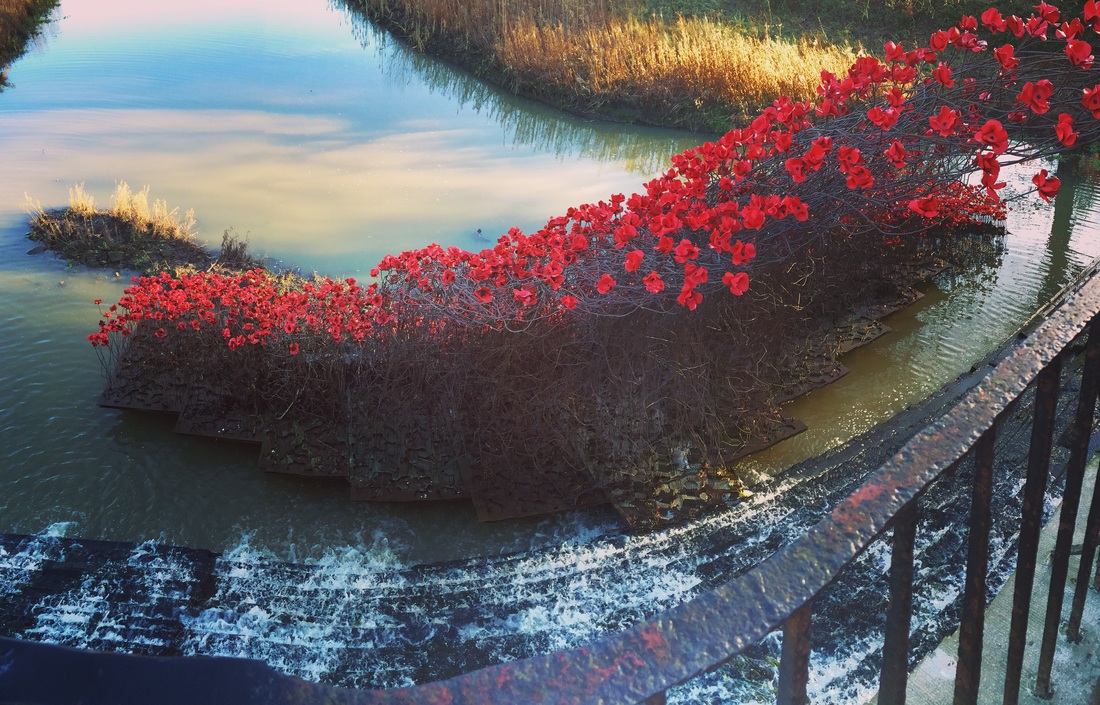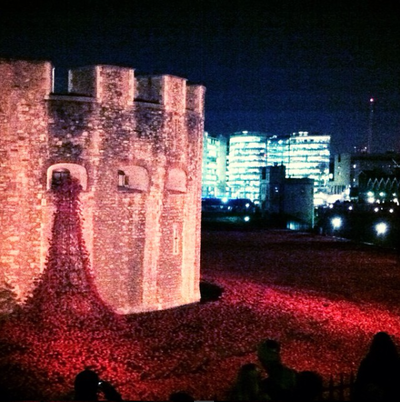| One of the reasons I love London is its amazing cultural offer. To my mind there’s nowhere else quite like it. During my time as an arts student in Yorkshire, many a Megabus journey was made to see blockbuster exhibitions at the Tate and such like over the years, and it was widely accepted that if you wanted to work in the arts, London was THE place to be. The exodus of artists seemingly leaving the capital is a sign that the times are perhaps a-changin'. Given that artists play a vital role in regeneration, it can only be a good thing to have a rising artistic presence in other UK towns and cities. That said, there’s little to celebrate about artistic talent being priced out of an area, and this is fast becoming one of London’s major failings. What I am pleased to see, however, is iconic art which has wowed the capital, and indeed world, making its way up the M1 to be enjoyed by the rest of the country. |
Specifically, I’m talking about Paul Cummins and Tom Piper’s ceramic Poppies and their tour across a number of venues nationwide.
Yorkshire Sculpture Park stole my heart aged 14 with its 500 acres of expansive landscapes strewn with world class sculptures. There was something quite lovely about seeing the iconic poppies again over the Christmas break, this time in a place synonymous in my mind with ‘Home’ and ‘Yorkshire’. And why shouldn’t rural visitors get a taste of the same brilliance that urban visitors enjoy with such ease, particularly given the symbolism of the art in question. Each poppy represents a death in the British forces during World War One; lest we forget that men were lost from every corner of our country, and beyond for that matter.
The poppies on tour are only a small fraction of the 888,246 poppies exhibited in the Tower of London’s 'Blood Swept Lands and Seas of Red’, however, the movement of them from site to site makes them lose their previous identity as ‘The Tower of London’ poppies - the artwork adapts to its new location and takes on new meaning, becoming relevant to more people. The 5,800 poppies which make up ‘Wave’ create a contemplative environment when seen falling from YSP’s Cascade Bridge into the Lower Lake. There’s something profoundly peaceful about them tumbling into the water below, and visitors are able to get closer to the work, experiencing it in an altogether different way.
As people increasingly use the arts as a way to spend time with family and friends, it has never been more necessary for installations and exhibitions to be polycentric, not by having more art ‘up north’ than in London, rather by having more here AND there. When The Art Council’s Audience Agency conducted a report about rebalancing the cultural capital, they aptly spoke of an approach which ‘irrigates not drains’ from the capital city. Take the Turner Prize, it’s surely only right that it should occasionally grace the stage of alternative UK cities - Gateshead 2011, Derry-Londonderry 2013 and soon to be Hull in 2017 during the city's year in the spotlight as ‘City of Culture 2017’.
The demand for accessible internationally acclaimed art across the country is undoubtedly there; Wakefield’s Yorkshire Sculpture Park has reported a 170% rise in visitors since the poppies went on show in September. Of course, the seal of approval received by the press in London surely had a role to play in achieving these figures, but they remain impressive nonetheless and speak volumes about a desire for more of the same kind of thing.
The proximity to venues and ease of visiting cultural institutions in urban environments certainly means that they enjoy more visitors than rural venues. That said, data from The Audience Agency reveals that art enthusiasts will seek out arts experiences, no matter where they live.
So keep bringing it, and they will come.
Author: Sarah Moor
Yorkshire Sculpture Park stole my heart aged 14 with its 500 acres of expansive landscapes strewn with world class sculptures. There was something quite lovely about seeing the iconic poppies again over the Christmas break, this time in a place synonymous in my mind with ‘Home’ and ‘Yorkshire’. And why shouldn’t rural visitors get a taste of the same brilliance that urban visitors enjoy with such ease, particularly given the symbolism of the art in question. Each poppy represents a death in the British forces during World War One; lest we forget that men were lost from every corner of our country, and beyond for that matter.
The poppies on tour are only a small fraction of the 888,246 poppies exhibited in the Tower of London’s 'Blood Swept Lands and Seas of Red’, however, the movement of them from site to site makes them lose their previous identity as ‘The Tower of London’ poppies - the artwork adapts to its new location and takes on new meaning, becoming relevant to more people. The 5,800 poppies which make up ‘Wave’ create a contemplative environment when seen falling from YSP’s Cascade Bridge into the Lower Lake. There’s something profoundly peaceful about them tumbling into the water below, and visitors are able to get closer to the work, experiencing it in an altogether different way.
As people increasingly use the arts as a way to spend time with family and friends, it has never been more necessary for installations and exhibitions to be polycentric, not by having more art ‘up north’ than in London, rather by having more here AND there. When The Art Council’s Audience Agency conducted a report about rebalancing the cultural capital, they aptly spoke of an approach which ‘irrigates not drains’ from the capital city. Take the Turner Prize, it’s surely only right that it should occasionally grace the stage of alternative UK cities - Gateshead 2011, Derry-Londonderry 2013 and soon to be Hull in 2017 during the city's year in the spotlight as ‘City of Culture 2017’.
The demand for accessible internationally acclaimed art across the country is undoubtedly there; Wakefield’s Yorkshire Sculpture Park has reported a 170% rise in visitors since the poppies went on show in September. Of course, the seal of approval received by the press in London surely had a role to play in achieving these figures, but they remain impressive nonetheless and speak volumes about a desire for more of the same kind of thing.
The proximity to venues and ease of visiting cultural institutions in urban environments certainly means that they enjoy more visitors than rural venues. That said, data from The Audience Agency reveals that art enthusiasts will seek out arts experiences, no matter where they live.
So keep bringing it, and they will come.
Author: Sarah Moor
Wave is on show at YSP until 10 January 2016.
Yorkshire Sculpture Park, West Bretton, Wakefield, WF4 4LG.
Track the poppies on their nationwide tour here: http://www.1418now.org.uk/commissions/poppies/2015locations/
References:
https://audienceagents.wordpress.com/2013/10/30/intelligent-debate-the-rebalancing-our-cultural-capital-report/
https://www.theaudienceagency.org/insight/urban-vs-rural-audiences
Yorkshire Sculpture Park, West Bretton, Wakefield, WF4 4LG.
Track the poppies on their nationwide tour here: http://www.1418now.org.uk/commissions/poppies/2015locations/
References:
https://audienceagents.wordpress.com/2013/10/30/intelligent-debate-the-rebalancing-our-cultural-capital-report/
https://www.theaudienceagency.org/insight/urban-vs-rural-audiences







 RSS Feed
RSS Feed
